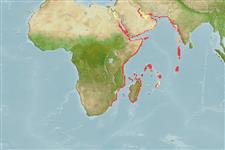Teleostei (teleosts) >
Blenniiformes (Blennies) >
Blenniidae (Combtooth blennies) > Salariinae
Etymology: Ecsenius: Greek, exenios, -os, -on = uncontrolled, immoderate.
More on author: Smith.
Environment: milieu / climate zone / depth range / distribution range
Ecology
Marine; reef-associated. Tropical
Western Indian Ocean: west of mid-Indian ocean ridge, north to Djetta, Saudi Arabia and south to Sodwana Bay, South Africa, and Cargados Carajos [=St. Brandon's Shoals].
Size / Weight / Age
Maturity: Lm ? range ? - ? cm
Max length : 6.5 cm TL male/unsexed; (Ref. 9710)
Adults inhabit coral reefs (Ref. 9710). Are mesoplankton feeders (Ref. 94107). Oviparous. Eggs are demersal and adhesive (Ref. 205), and are attached to the substrate via a filamentous, adhesive pad or pedestal (Ref. 94114). Larvae are planktonic, often found in shallow, coastal waters (Ref. 94114).
Life cycle and mating behavior
Maturity | Reproduction | Spawning | Eggs | Fecundity | Larvae
Oviparous, distinct pairing (Ref. 205).
Springer, V.G., 1988. The Indo-Pacific blenniid fish genus Ecsenius. Smithson. Contrib. Zool. (465):134 p. (Ref. 5296)
IUCN Red List Status (Ref. 130435: Version 2024-1)
Threat to humans
Harmless
Human uses
Tools
Special reports
Download XML
Internet sources
Estimates based on models
Preferred temperature (Ref.
123201): 25.4 - 29.1, mean 27.5 °C (based on 649 cells).
Phylogenetic diversity index (Ref.
82804): PD
50 = 0.5000 [Uniqueness, from 0.5 = low to 2.0 = high].
Bayesian length-weight: a=0.00603 (0.00298 - 0.01218), b=2.90 (2.73 - 3.07), in cm total length, based on LWR estimates for this species & (Sub)family-body (Ref.
93245).
Trophic level (Ref.
69278): 2.0 ±0.00 se; based on food items.
Resilience (Ref.
120179): High, minimum population doubling time less than 15 months (Preliminary K or Fecundity.).
Fishing Vulnerability (Ref.
59153): Low vulnerability (10 of 100).
Nutrients (Ref.
124155): Calcium = 219 [104, 399] mg/100g; Iron = 1.03 [0.58, 1.87] mg/100g; Protein = 17.8 [16.5, 18.9] %; Omega3 = 0.0891 [, ] g/100g; Selenium = 25.4 [11.5, 60.3] μg/100g; VitaminA = 113 [27, 472] μg/100g; Zinc = 3.1 [2.0, 4.6] mg/100g (wet weight);
